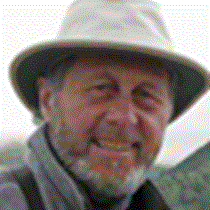Isla Magdalena & Boca de Soledad, Baja California
The star talk scheduled by our Expedition Leader for 4:30am today drew less than a stellar crowd. Even the leader was a no-show. It is obviously difficult to catch an April Fool on the National Geographic Sea Lion. But we had takers of another kind. Shortly after a cloud-filtered sunrise, a mother gray whale led her robust calf very close to our anchored ship and then continued south in the quiet waters of the canal. Wide eyes and rapid-fire cameras recorded this short parade. Soon after, they or another mother/calf pair drifted past us, this time heading north in a similar leisurely fashion. This was our invitation to hop into soft-sided Zodiacs to get close to these magnificent creatures as they explored their nursery habitat. These whales seem entirely receptive to small boats that hold strange, gangly creatures, even after humans twice drove them almost to extinction. We followed quietly behind them, puzzling over their every move. What was going on under the surface? There could be no doubt that tactile contact between mother and calf, and nursing, were important. The baby must gain hundreds of pounds per week, both muscle and insulating blubber, in order to survive a long and challenging swim north to cold Arctic waters. Before noon, the unimaginable curiosity that this species has shown in the past few decades began. They bumped and played with our boats, even allowing anxious hands to reach down to touch them.
Our southbound passage in Canal de la Magdalena brought us birds and coyotes. Egrets, herons and tall shorebirds lined the rich intertidal zone. Ospreys plunged. Even normally secretive clapper rails were feeding well away from the protective mangrove roots, and two bald eagles, a species at the southern extremity of its range here in Baja California, made an appearance.
The late afternoon drew us to shore again. All photographers know that the sweet light of sunrise and sunset can produce stunning scenes. When that light shines low on endless, untouched sand dunes and curious plant forms that struggle to keep above the drifting sand, the good photographers are happy. And the rest of us learned from the experts today, about some of the basics of good photography and about how to tell a story with photographs. Now we each have more time and a great incentive to practice.
The star talk scheduled by our Expedition Leader for 4:30am today drew less than a stellar crowd. Even the leader was a no-show. It is obviously difficult to catch an April Fool on the National Geographic Sea Lion. But we had takers of another kind. Shortly after a cloud-filtered sunrise, a mother gray whale led her robust calf very close to our anchored ship and then continued south in the quiet waters of the canal. Wide eyes and rapid-fire cameras recorded this short parade. Soon after, they or another mother/calf pair drifted past us, this time heading north in a similar leisurely fashion. This was our invitation to hop into soft-sided Zodiacs to get close to these magnificent creatures as they explored their nursery habitat. These whales seem entirely receptive to small boats that hold strange, gangly creatures, even after humans twice drove them almost to extinction. We followed quietly behind them, puzzling over their every move. What was going on under the surface? There could be no doubt that tactile contact between mother and calf, and nursing, were important. The baby must gain hundreds of pounds per week, both muscle and insulating blubber, in order to survive a long and challenging swim north to cold Arctic waters. Before noon, the unimaginable curiosity that this species has shown in the past few decades began. They bumped and played with our boats, even allowing anxious hands to reach down to touch them.
Our southbound passage in Canal de la Magdalena brought us birds and coyotes. Egrets, herons and tall shorebirds lined the rich intertidal zone. Ospreys plunged. Even normally secretive clapper rails were feeding well away from the protective mangrove roots, and two bald eagles, a species at the southern extremity of its range here in Baja California, made an appearance.
The late afternoon drew us to shore again. All photographers know that the sweet light of sunrise and sunset can produce stunning scenes. When that light shines low on endless, untouched sand dunes and curious plant forms that struggle to keep above the drifting sand, the good photographers are happy. And the rest of us learned from the experts today, about some of the basics of good photography and about how to tell a story with photographs. Now we each have more time and a great incentive to practice.



